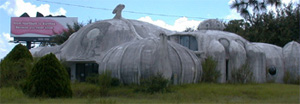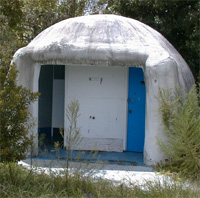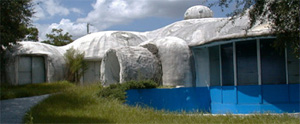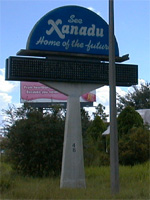America loves plastic. We drink from it, we drive it, we buy with it, and we even save it so we can make more plastic out of it. A day does not go by that we don't partake in some form of interaction with plastic. So why not live in it?
This may have been the stream of conscience of Bob Masters and Roy Mason when in the early 1980s they came up with the idea of Xanadu in Kissimmee. It was a look into the future of homes that would never be. In the end, the two masterminds of Xanadu would find their enlightened prototype made a better roadside shrine.
When Epcot (Experimental Prototype Community of Tomorrow) was first opening it's doors, the Xanadu home on Route 192 seemed to be the perfect pit stop on any family's voyage into tomorrowland. It was the proverbial icing on the space cake. Construction of the house was achieved by spraying a thick layer of polyurethane foam onto balloon-like forms. The result was an oddly-shaped, energy efficient home that was cheap to build and as tacky as a strip of flypaper. Inside the plastic palace were tiny stairwells that spiraled to a second floor of cave-looking living space. Ceilings in these rooms were three feet high. To emphasize that this was the future, an eclectic mass of mismatched computers and electronics were spread throughout. Accenting insult to injury was the fireplace - a large mushroom structure in the center of the living room into which a video monitor was molded - playing a video of a burning log. Visitors were given wireless phones that guided them through the house in cheesy, Plan 9 From Outer Space-style computer voices. More often than not their signals were jammed by any electrical interference in the room.
The Xanadu home was one of three such structures built in the United States. The others, which have since been destroyed, were in Wisconsin Dells, WI and Gatlinburg, TN. All were promoted as "environmentally sensitive" homes of tomorrow.
Not everyone greeted the future of homes with the same optimism as their creators. Thomas Gussel earned his place in history as the first consumer advocate against bubble dwellings. "It's like turning over a Styrofoam cup and living in it!" In 1996 Xanadu became a thing of the past rather than the future. Modern society was moving faster than any vision of what would be. The Internet made its inception into everyday living and Windows became standard in most homes. It all made the prospect of living in a cave with a bunch of DOS based machines about as anti-climatic as a Toto reunion tour.
The property went up for sale, but three years later there still were no takers. The owners started to use the building as storage space. There was also a rumor in 1998 that it was going to be turned into a daycare center. As of today, the building is still holding its ground and reasonable offers will be accepted. As the woman at the Kissimmee Visitors Bureau so gingerly put it, "Yeah it's still here. What an eyesore!" Update 4/02: Back on Tack was informed by a student at Valencia Community College that a Government advisor on campus claims, Xanadu was added to the National Register of Historic Places. There may be hope for the future after all! Update 7/01: The asking price of $440,000 has jumped to $1.7 million. Some say it is a deviant plot to have a hotel chain demolish it. A "save the foam dome" grassroots campaign may be in the works.
Remains of Xanadu |



